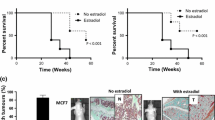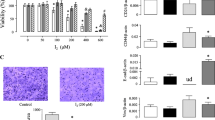Abstract
We have determined the effect of combining the chemotherapy agent doxorubicin and the anti-resorptive drug zoledronic acid on the early stages of spontaneous mammary tumour development using the immunocompetent PyMT mouse model that closely mimics human breast cancer development. 6-week-old PyMT mice were treated weekly for 6 weeks with PBS, 2 mg/kg doxorubicin, 100 μg/kg zoledronic acid or doxorubicin followed 24 h later by zoledronic acid (n = 15/group). Untreated, 6-week-old animals were used for comparison of tumour development. Tumour volume, apoptosis and angiogenesis were analysed on H&E, caspase 3, CD31 and CD34 stained histological sections. Proliferation was measured by BrdU incorporation and Ki67 staining and tumour macrophage infiltration assessed by F4/80 immunohistochemistry. Animals treated with doxorubicin followed by zoledronic acid did not develop palpable mammary tumours, whereas in all other treatment groups tumours progressed to late stage adenocarcinomas. Tumours from the combination treatment group were of comparable size to those in 6-week-old untreated animals, remaining pre-malignant with well-differentiated acinar arrangements and with tumour volume only reaching on average 26% of that in the PBS control group. Tumour cell apoptosis and proliferation was significantly reduced compared to control, single agent or untreated 6-week-old mice. Significantly fewer circulating tumour cells were present in animals following sequential treatment compared to all other groups. Combination treatment with doxorubicin followed by zoledronic acid inhibits development and progression of spontaneously occurring mammary tumours.






Similar content being viewed by others
References
Costa L, Harper P, Coleman RE, Lipton A (2011) Anticancer evidence for zoledronic acid across the cancer continuum. Crit Rev Oncol Hematol 77(Suppl 1):S31–S37
Van Beek E, Pieterman E, Cohen L, Lowik C, Papapoulos S (1999) Farnesyl pyrophosphate synthase is the molecular target of nitrogen-containing bisphosphonates. Biochem Biophys Res Commun 264(1):108–111
Coxon FP, Helfrich MH, Van’t Hof R, Sebti S, Ralston SH, Hamilton A, Rogers MJ (2000) Protein geranylgeranylation is required for osteoclast formation, function, and survival: inhibition by bisphosphonates and GGTI-298. J Bone Miner Res 15(8):1467–1476
Dunford JE, Thompson K, Coxon FP, Luckman SP, Hahn FM, Poulter CD, Ebetino FH, Rogers MJ (2001) Structure-activity relationships for inhibition of farnesyl diphosphate synthase in vitro and inhibition of bone resorption in vivo by nitrogen-containing bisphosphonates. J Pharmacol Exp Ther 296(2):235–242
Rogers MJ, Gordon S, Benford HL, Coxon FP, Luckman SP, Monkkonen J, Frith JC (2000) Cellular and molecular mechanisms of action of bisphosphonates. Cancer 88(12 Suppl):2961–2978
Benford HL, McGowan NW, Helfrich MH, Nuttall ME, Rogers MJ (2001) Visualization of bisphosphonate-induced caspase-3 activity in apoptotic osteoclasts in vitro. Bone 28(5):465–473
Lee MV, Fong EM, Singer FR, Guenette RS (2001) Bisphosphonate treatment inhibits the growth of prostate cancer cells. Cancer Res 61(6):2602–2608
Shipman CM, Rogers MJ, Apperley JF, Russell RG, Croucher PI (1997) Bisphosphonates induce apoptosis in human myeloma cell lines: a novel anti-tumour activity. Br J Haematol 98(3):665–672
Senaratne SG, Pirianov G, Mansi JL, Arnett TR, Colston KW (2000) Bisphosphonates induce apoptosis in human breast cancer cell lines. Br J Cancer 82(8):1459–1468
van der Pluijm G, Vloedgraven H, van Beek E, van der Wee-Pals L, Lowik C, Papapoulos S (1996) Bisphosphonates inhibit the adhesion of breast cancer cells to bone matrices in vitro. J Clin Invest 98(3):698–705
Boissier S, Magnetto S, Frappart L, Cuzin B, Ebetino FH, Delmas PD, Clezardin P (1997) Bisphosphonates inhibit prostate and breast carcinoma cell adhesion to unmineralized and mineralized bone extracellular matrices. Cancer Res 57(18):3890–3894
Boissier S, Ferreras M, Peyruchaud O, Magnetto S, Ebetino FH, Colombel M, Delmas P, Delaissé JM, Clézardin P (2000) Bisphosphonates inhibit breast and prostate carcinoma cell invasion, an early event in the formation of bone metastases. Cancer Res 60(11):2949–2954
Basi DL, Lee SW, Helfman S, Mariash A, Lunos SA (2010) Accumulation of VEGFR2 in zoledronic acid-treated endothelial cells. Mol Med Report 3(3):399–403
Green JR, Guenther A (2011) The backbone of progress—preclinical studies and innovations with zoledronic acid. Crit Rev Oncol Hematol 77(Suppl 1):S3–S12
Brown HK, Ottewell PD, Coleman RE, Holen I (2011) The kinetochore protein Cenp-F is a potential novel target for zoledronic acid in breast cancer cells. J Cell Mol Med 15(3):501–513
Hiraga T, Williams PJ, Ueda A, Tamura D, Yoneda T (2004) Zoledronic acid inhibits visceral metastases in the 4T1/luc mouse breast cancer model. Clin Cancer Res 10(13):4559–4567
Corey E, Brown LG, Quinn JE, Poot M, Roudier MP, Higano CS, Vessella RL (2003) Zoledronic acid exhibits inhibitory effects on osteoblastic and osteolytic metastases of prostate cancer. Clin Cancer Res 9(1):295–306
Gao L, Deng H, Zhao H, Hirbe A, Harding J, Ratner L, Weilbaecher K (2005) HTLV-1 Tax transgenic mice develop spontaneous osteolytic bone metastases prevented by osteoclast inhibition. Blood 106(13):4294–4302
Croucher PI, De Hendrik R, Perry MJ, Hijzen A, Shipman CM, Lippitt J, Green J, Van Marck E, Van Camp B, Vanderkerken K (2003) Zoledronic acid treatment of 5T2MM-bearing mice inhibits the development of myeloma bone disease: evidence for decreased osteolysis, tumor burden and angiogenesis, and increased survival. J Bone Miner Res 18(3):482–492
Kim SJ, Uehara H, Yazici S, He J, Langley RR, Mathew P, Fan D, Fidler IJ (2005) Modulation of bone microenvironment with zoledronate enhances the therapeutic effects of STI571 and paclitaxel against experimental bone metastasis of human prostate cancer. Cancer Res 65(9):3707–3715
Heymann D, Ory B, Blanchard F, Heymann MF, Coipeau P, Charrier C, Couillaud S, Thiery JP, Gouin F, Redini F (2005) Enhanced tumor regression and tissue repair when zoledronic acid is combined with ifosfamide in rat osteosarcoma. Bone 37(1):74–86
Hiraga T, Ueda A, Tamura D, Hata K, Ikeda F, Williams PJ, Yoneda T (2003) Effects of oral UFT combined with or without zoledronic acid on bone metastasis in the 4T1/luc mouse breast cancer. Int J Cancer 106(6):973–979
Melisi D, Caputo R, Damiano V, Bianco R, Veneziani BM, Bianco AR, De Placido S, Ciardiello F, Tortora G (2005) Zoledronic acid cooperates with a cyclooxygenase-2 inhibitor and gefitinib in inhibiting breast and prostate cancer. Endocr Relat Cancer 12(4):1051–1058
Zhou Z, Guan H, Duan X, Kleinerman ES (2005) Zoledronic acid inhibits primary bone tumor growth in Ewing sarcoma. Cancer 104(8):1713–1720
Segawa H, Kimura S, Kuroda J, Sato K, Yokota A, Kawata E, Kamitsuji Y, Ashihara E, Yuasa T, Fujiyama Y, Ottmann OG, Maekawa T (2005) Zoledronate synergises with imatinib mesylate to inhibit Ph primary leukaemic cell growth. Br J Haematol 130(4):558–560
Suva LJ (2010) Adjuvant bisphosphonates in breast cancer: the ABCSG-12 study. Curr Osteoporos Rep 8(2):57–59
Coleman RE (2011) Is caring for bone also fighting the breast cancer? Breast 20(Suppl 1):S2
Ottewell PD, Deux B, Mönkkönen H, Cross S, Coleman RE, Clezardin P, Holen I (2008) Differential effect of doxorubicin and zoledronic acid on intraosseous versus extraosseous breast tumor growth in vivo. Clin Cancer Res 14(14):4658–4666
Ottewell PD, Mönkkönen H, Jones M, Lefley DV, Coleman RE, Holen I (2008) Antitumor effects of doxorubicin followed by zoledronic acid in a mouse model of breast cancer. J Natl Cancer Inst 100(16):1167–1178
Ottewell PD, Lefley DV, Cross SS, Evans CA, Coleman RE, Holen I (2010) Sustained inhibition of tumor growth and prolonged survival following sequential administration of doxorubicin and zoledronic acid in a breast cancer model. Int J Cancer 126(2):522–532
Lin EY, Jones JG, Li P, Zhu L, Whitney KD, Muller WJ, Pollard JW (2003) Progression to malignancy in the polyoma middle T oncoprotein mouse breast cancer model provides a reliable model for human diseases. Am J Pathol 163(5):2113–2126
Qiu TH, Chandramouli GV, Hunter KW, Alkharouf NW, Green JE, Liu ET (2004) Global expression profiling identifies signatures of tumor virulence in MMTV-PyMT-transgenic mice: correlation to human disease. Cancer Res 64(17):5973–5981
Wang S, Yuan Y, Liao L, Kuang SQ, Tien JC, O’Malley BW, Xu J (2009) Disruption of the SRC-1 gene in mice suppresses breast cancer metastasis without affecting primary tumor formation. Proc Natl Acad Sci USA 106(1):151–156
Ritland SR, Rowse GJ, Chang Y, Gendler SJ (1997) Loss of heterozygosity analysis in primary mammary tumors and lung metastases of MMTV-MTAg and MMTV-neu transgenic mice. Cancer Res 57(16):3520–3525
Kyle AH, Huxham LA, Baker JH, Burston HE, Minchinton AI (2003) Tumor distribution of bromodeoxyuridine-labeled cells is strongly dose dependent. Cancer Res 63(18):5707–5711
Marshman E, Ottewell PD, Potten CS, Watson AJ (2001) Caspase activation during spontaneous and radiation-induced apoptosis in the murine intestine. J Pathol 195(3):285–292
Smith PK, Krohn RI, Hermanson GT, Mallia AK, Gartner FH, Provenzano MD, Fujimoto EK, Goeke NM, Olson BJ, Klenk DC (1985) Measurement of protein using bicinchoninic acid. Anal Biochem 150:76–85
Giraudo E, Inoue M, Hanahan D (2004) An amino-bisphosphonate targets MMP-9-expressing macrophages and angiogenesis to impair cervical carcinogenesis. J Clin Invest 114(5):623–633
Duyndam MC, van Berkel MP, Dorsman JC, Rockx DA, Pinedo HM, Boven E (2007) Cisplatin and doxorubicin repress Vascular Endothelial Growth Factor expression and differentially down-regulate Hypoxia-inducible Factor I activity in human ovarian cancer cells. Biochem Pharmacol 74(2):191–201
Ottewell PD, Woodward JK, Lefley DV, Evans CA, Coleman RE, Holen I (2009) Anticancer mechanisms of doxorubicin and zoledronic acid in breast cancer tumor growth in bone. Mol Cancer Ther 8(10):2821–2832
Lin EY, Li JF, Gnatovskiy L, Deng Y, Zhu L, Grzesik DA, Qian H, Xue XN, Pollard JW (2006) Macrophages regulate the angiogenic switch in a mouse model of breast cancer. Cancer Res 66(23):11238–11246
Neville-Webbe HL, Rostami-Hodjegan A, Evans CA, Coleman RE, Holen I (2005) Sequence- and schedule-dependent enhancement of zoledronic acid induced apoptosis by doxorubicin in breast and prostate cancer cells. Int J Cancer 113(3):364–371
Fornari FA, Randolph JK, Yalowich JC, Ritke MK, Gewirtz DA (1994) Interference by doxorubicin with DNA unwinding in MCF-7 breast tumor cells. Mol Pharmacol 45(4):649–656
Fornari FA Jr, Jarvis WD, Grant S, Orr MS, Randolph JK, White FK, Mumaw VR, Lovings ET, Freeman RH, Gewirtz DA (1994) Induction of differentiation and growth arrest associated with nascent (nonoligosomal) DNA fragmentation and reduced c-myc expression in MCF-7 human breast tumor cells after continuous exposure to a sublethal concentration of doxorubicin. Cell Growth Differ 5(7):723–733
Winter MC, Evans A, Holen I, Coleman RE (2010) Exploring the anti-angiogenic potential of zoledronic acid in combination with neoadjuvant chemotherapy in invasive breast cancer. Bone 47(Suppl 2):S310–S310
Lynn KD, Udugamasooriya DG, Roland CL, Castrillon DH, Kodadek TJ, Brekken RA (2010) GU81, a VEGFR2 antagonist peptoid, enhances the anti-tumor activity of doxorubicin in the murine MMTV-PyMT transgenic model of breast cancer. BMC Cancer 10:397
Coscia M, Quaglino E, Iezzi M, Curcio C, Pantaleoni F, Riganti C, Holen I, Mönkkönen H, Boccadoro M, Forni G, Musiani P, Bosia A, Cavallo F, Massaia M (2010) Zoledronic acid repolarizes tumour-associated macrophages and inhibits mammary carcinogenesis by targeting the mevalonate pathway. J Cell Mol Med 14(12):2803–2815
Woodward JK, Neville-Webbe HL, Coleman RE, Holen I (2005) Combined effects of zoledronic acid and doxorubicin on breast cancer cell invasion in vitro. Anticancer Drugs 16(8):845–854
Thompson K, Rogers MJ, Coxon FP, Crockett JC (2006) Cytosolic entry of bisphosphonate drugs requires acidification of vesicles after fluid-phase endocytosis. Mol Pharmacol 69(5):1624–1632
Acknowledgments
We would like to thank Mrs Jenny Globe (University of Sheffield, United Kingdom) for cutting histological tissue sections, Mrs Alyson Evans and Mrs Diane Lefley for performing immunohistochemistry and Dr. Jonathan Green (Novartis Pharma, Switzerland) for the kind gift of zoledronic acid. This study was funded by Breast Cancer Campaign, UK.
Author information
Authors and Affiliations
Corresponding author
Rights and permissions
About this article
Cite this article
Ottewell, P.D., Brown, H.K., Jones, M. et al. Combination therapy inhibits development and progression of mammary tumours in immunocompetent mice. Breast Cancer Res Treat 133, 523–536 (2012). https://doi.org/10.1007/s10549-011-1782-x
Received:
Accepted:
Published:
Issue Date:
DOI: https://doi.org/10.1007/s10549-011-1782-x




